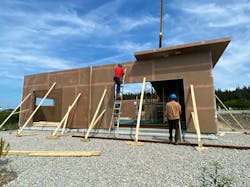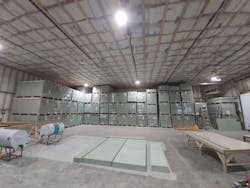Homebuilders tout warmth, sturdiness of houses with plastics at their core
This story appeared in the Fall 2022 issue of Plastics Recycling magazine.
By Karen Hanna
A story parents share with young children envisions three pigs building houses for themselves as protection against a big, bad wolf.
Of the three building materials they try — sticks, straw and brick — only brick is left standing.
Too bad they didn’t consider plastic.
“So far, there’s six in Canada, with about six or seven more to go up by the end of this fall between our partners out East and ourselves,” said Kelly Rogers, managing partner of Ecoplast, Lloydminster, Alberta. “There’s six in the world here so far, and each house has about between 600,000 to a million bottles.”
Using a proprietary process, JD Composites shreds, pelletizes and melts down plastic bottles that would otherwise be sent to landfills or incinerators, Rogers said. It then extrudes the recyclate into foam boards and bonds them with special, in-house laminates to create sealed monolithic structures.
Homebuyers can work with designers at JD Composites or Ecoplast to create their own storybook houses, or choose from some designs that already have gone up. Prior designs bear names like Prairie Paradise Bungalow — which might look at home in a middle-class, postwar subdivision — and Saskatchewan Sunrise, which features a second-story deck and a generous helping of windows to exploit the sun’s rays.
In addition to breathing new life into waste plastics, the structures offer a number of advantages over homes built with more traditional materials, Rogers said.
They are well-insulated, and immune to rot, mold and bugs, like termites, Rogers. They also offer the potential for an attribute not often associated with home construction: speed.
“We make all the panels in our facilities, so it’s all controlled indoors. All the openings are pre-cut; everything’s planned out. And then, when we go on-site, we just stand them up, put them together, and it’s just quick,” he said.
Workers can assemble the frame of a home in just 14 to 17 hours, he said.
As long customer have purchased land, the homes can come together, from drawings to move-in ready condition, in two or three months, Rogers said. That includes a couple weeks for the design and engineering process; four to six weeks for the manufacturing process; a week for shipping; and another week or so for on-site work, including finishing.
The foam cores are compatible are compatible with many exterior finishes and building materials, including vinyl, cladding and paint.
A heating, ventilation and air-conditioning specialist, Rogers joined Ecoplast because he was intrigued by plastics’ insulating potential. The process delivers — with 6-inch foam cores providing an R-value of 30, he said. That’s significantly higher than the levels of insulation Canadian province building codes require, contributing to levels of energy-efficiency nearly double other newly built homes. Depending on the structure and jurisdiction, other homes in Canada can have effective R-values of 17, Rogers said.
“If you’re in the house, you’d never know that it was made from PET plastics,” he said. “It’s your building envelope, so, it’s your structural [frame], your insulation, air barrier, vapor barrier, all in one.”
According to Ecoplast, the homes are resilient against many of the issues associated with climate change, including floods, storms, Category 5 hurricane-force winds and extreme temperatures. The company says the foam cores can achieve a Class A fire rating, depending on the exterior treatment process, meaning they will not release incandescent particles or allow flames to spread. Compared with other insulation materials, the cores burn with less energy and produce smaller amounts of toxins.
Cost depends on homebuyers’ particular requirements, but Ecoplast homes can be comparable to other new builds, Rogers said.
“It depends on the design, but a 1,600-square-foot home … might be around $130,000 for the building envelope, assembled on-site. … And then you add your windows and doors and finish it out,” he said. “It’s on par in a lot of areas with stick-build and other conventional building methods.”
Four years after JD Composites began building PET-foam-core homes, Rogers still expresses admiration for plastics’ insulating capabilities. But the project’s potential goes far beyond those benefits.
Asked what drives him, he said: “The opportunity to make an environmentally friendly product. And having the flexibility to turn it into something, to create someone’s dream home and be creative. It’s something that works really well.”
Ecoplast is poised to grow, he said.
While the company currently aims to build about six to 10 homes a year, it knows its feedstock is nearly endless, even considering how much PET already is recycled.
“There’s enough out there in Canada above ground that we could build 3,500 homes a year for 40 years. That’s just currently, and there’s a lot more made every day,” Rogers said.
Karen Hanna, senior staff reporter
About the Author
Karen Hanna
Senior Staff Reporter
Senior Staff Reporter Karen Hanna covers injection molding, molds and tooling, processors, workforce and other topics, and writes features including In Other Words and Problem Solved for Plastics Machinery & Manufacturing, Plastics Recycling and The Journal of Blow Molding. She has more than 15 years of experience in daily and magazine journalism.


